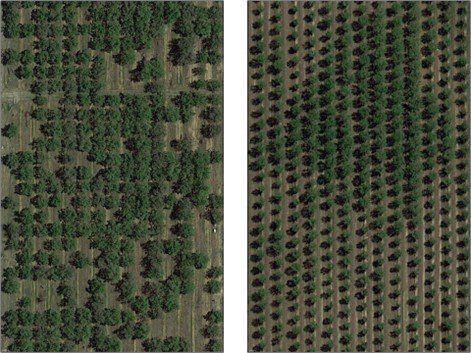
Removing and replanting an orchard can be a difficult decision, but ultimately orchards will need to be replaced. When replanting, it is important to identify what problems may persist into the next orchard and what can be done to mitigate these issues.
Satellite images provide a bird’s eye view of the current orchard and can help differentiate between “good” and “problem” areas. Resources like Google Earth even provide options to go back in time to view problem areas in previous orchards and see how the current orchard developed. Areas of poorly growing trees can be used to predict potential problems that may persist into the new orchard and narrow the list of potential problems to identify. For example, different patterns of tree loss, decline or growth can indicate different potential issues.
Consistent canopy size with sporadic tree loss can indicate a problem with soilborne pathogens, which would require in-field observations and possibly sampling tree roots or crowns for pathogens as well as soil for parasitic nematodes. Decline down a tree row could indicate an irrigation problem which would require assessing the irrigation system. Variable canopy growth localized within irregular shapes could indicate a soil variability problem like different soil textures, uneven water infiltration or variable hardpan depth. Growers should also utilize online soil maps, like those provided by University of California, Davis’ SoilWeb apps or the USDA Web Soil Survey. Finally, always ground truth areas of poor tree performance by deep soil sampling with a six-foot auger or a backhoe to assess soil to at least a six-foot depth.
Satellite images begin to inform how funds, time and other resources should be best allotted to establish a new orchard by helping identify replant issues, which for almonds can be categorized into the following groups:
- Physical and chemical factors
- Aggressive pathogens
- Plant-parasitic nematodes
- Prunus replant disease
Some are addressed by pre-plant treatments (e.g., fumigation to control soilborne pests), while others are addressed by orchard management after planting (e.g., nutrient deficiency), and others may be solved through the normal practices of replanting an orchard (e.g., upgrading the irrigation system). Many of these problems may be mitigated by choosing an appropriate rootstock. However, issues need to be identified first to then inform if something needs to be done and, if so, the best management strategy to mitigate replant impacts.
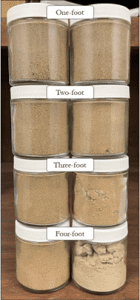
Physical and Chemical Factors
If physical and chemical factors are suspected, sampling and analyzing leaf tissue, soil and irrigation water is useful to identify problems with salinity, high levels of boron, pH or variability in soil textures. If a suspected problem is localized to specific areas in the orchard, generally it is worth submitting separate samples for “good” areas and “problem” areas. When using a backhoe or auger, look for sudden changes in soil texture, color or hardness. Any sudden change in soil texture requires ripping or backhoeing to mix the soil to prevent water infiltration problems. Failure to properly break up or mix soil layering will lead to root health problems and premature orchard decline.
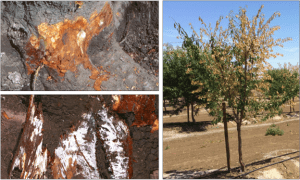
Aggressive Pathogens
Aggressive pathogens can also persist in the new orchard. Typically, these should be identified from observing and sampling failing trees from the previous orchard. For example, almond roots infected with Armillaria root rot or oak root fungus (Armillaria mellea) may have white mats between the bark and wood. While some pathogens may be identifiable in the field, samples should be sent to labs to confirm a diagnosis. This can be done with help from a local farm advisor or PCA.
The UC Integrated Pest Management Program is a resource that can help identify a problem and provide recommendations on what can be done. Generally, using a resistant rootstock is the best way to mitigate challenges with aggressive pathogens in replanted orchards, so refer to the UC ANR rootstock database or the rootstock comparison chart for more information.
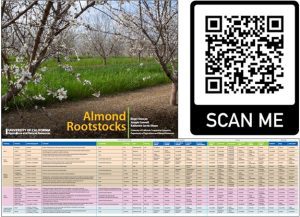
Plant Parasitic Nematodes
A common challenge for replanted orchards is the presence of plant parasitic nematodes, such as root-knot, root lesion and ring nematodes. While many other species of nematodes live freely in the soil and are not detrimental to crops, plant parasitic nematodes can impact root health and development, which impacts tree vigor.
Soil and root sampling can help determine if parasitic nematodes are present in a field and, if present, type and number of nematodes. As nematodes are not distributed evenly across a field, appropriate sampling methods should be implemented to collect a representative sample. Below are some guidelines to help sample for parasitic nematodes:
Fall sampling: Sample in fall as nematode populations are the highest during this time, allowing the best chance of detecting them.
Tools: Shovel, soil probe or auger.
Depth: For almonds, collect soil from 4 to 24 inches below the soil surface. Use a shovel to clear away the top four inches of soil and use a soil probe or auger to sample from there to 24 inches deep.
Location: Collect soil from multiple spots in an orchard and then combine these into one sample with a total volume of about 16 oz (or about 2 cups). Sample near trees in order to include roots with the soil sample. Collect soil from at least five locations in one orchard (more for larger blocks). Make sure to sample across the orchard, not just right next to the road. Samples are supposed to represent an orchard’s nematode populations, so take extra effort to sample enough locations. As with physical and chemical soil sampling, you might consider submitting separate samples for “good” areas and “problem” areas in your orchard.
Sanitize: Sanitize your tools before beginning to sample, when sampling a new orchard and between “good” and “problem” area sampled in one orchard. Contaminated tools can lead to lab results detecting nematodes in many fields when they were really just present in one field. Remove any stuck-on soil and then use appropriate disinfectants or flame with a propane torch to sanitize tools.
Label sample: Clearly mark the sample with the location and date. Location is especially important if you are submitting multiple samples.
Storage: Store samples in a cool location like a refrigerator or ice chest. This helps nematodes in the sample to survive long enough for lab analysis. If using an ice chest, insulate the samples from direct contact with the ice and protect samples from water as the ice melts.
Lab reports show what types of nematodes are present, as well as the number of each type per volume of soil. Sometimes it may be important to request more information from the lab analyzing samples. For example, there is more than one species of root lesion nematode, but only one is considered to be a problem in orchard crops (Pratylenchus vulnus), so be sure to ask the lab to identify which species of root lesion nematode is present in your orchard. Which additional information is needed is dependent on your location and the types of plant parasitic nematodes that may be a concern in that location.
The most effective mitigation strategy will depend on both the type and number of nematodes present. For high nematode levels, pre-plant soil fumigation and the use of resistant rootstock might be the best option. At lower nematode numbers, the use of a resistant rootstock may be sufficient. Consult with a farm advisor or PCA to determine what strategies would be appropriate to help manage your specific nematode situation.

Prunus Replant Disease
Prunus replant disease is a challenge for many almond orchards planted following almond or other Prunus species. The causes are poorly understood but the disease is characterized by reduced tree growth in replanted orchards. It typically occurs in loam, sandy loam and sandy soil textures, and can occur with or without plant parasitic nematodes. Unfortunately, there is no test for Prunus replant disease, but we know that fumigation and anaerobic soil disinfestation can help mitigate the problem. We also have evidence that waiting a year between removing the old orchard and planting the new orchard can help to mitigate this problem.
While removing and replanting an orchard is challenging, it is important to consider what issues the new orchard will face. Trying to fix problems after planting can be costly and difficult, and failing to adequately address these challenges can lead to failure of the replanted orchard. Make the time to identify, mitigate and plan for replant impacts before planting an orchard as this will give your trees the best start toward becoming healthy and profitable.
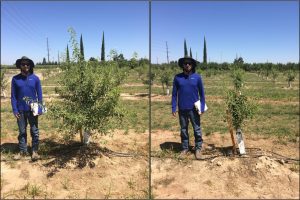
Resources
Contact the authors: Cameron Zuber at cazuber@ucanr.edu and Jaime Ott at njott@ucanr.edu
UC ANR rootstock comparison tool: fruitsandnuts.ucdavis.edu/rootstocks/rootstock-comparison
UC ANR rootstock comparison chart: fruitsandnuts.ucdavis.edu/almond-rootstock-comparison-chart
UC ANR rootstock database: fruitsandnuts.ucdavis.edu/rootstocks
UC IPM for Agricultural Pests: ipm.ucanr.edu/agriculture/
UC Davis, NRCS and UC ANR SoilWeb Apps: casoilresource.lawr.ucdavis.edu/soilweb-apps/
USDA Web Soil Survey: websoilsurvey.sc.egov.usda.gov/App/HomePage.htm















